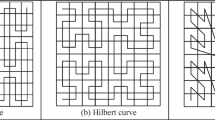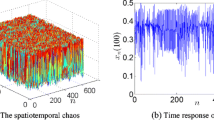Abstract
A double-image encryption algorithm combining DNA insertion and deletion operations with spatiotemporal chaos is proposed. The technology of DNA sequence insertion and deletion is employed in both confusion and diffusion to encrypt two images simultaneously. In the proposed image encryption scheme, the key streams to control DNA operations are obtained by means of iterating the system of non-adjacent coupled map lattices (NCML). The original key streams are related to the plain-image, which increases the sensitivity of the proposed algorithm. Two confused images are served as keys to encrypt each other. The confused image is associated with another through the DNA insertion and deletion, which not only improves the security of image encryption system but also enhances the encryption speed. It is demonstrated that the proposed image encryption algorithm has the characteristics of large key space, high sensitivities of key and plain-image, and high entropy. Also, the proposed algorithm is robust to occlusion-attack and noise-attack. Therefore, the proposed double-image encryption algorithm is heuristic for the DNA computing applications into the multi-image encryption.









Similar content being viewed by others
References
Ahmad M, Alam MZ, Ansari S et al (2018) Cryptanalysis of an image encryption algorithm based on PWLCM and inertial delayed neural network. J Intell Fuzzy Syst 34(3):1323–1332
Akhavan A, Samsudin A, Akhshani A et al (2017) Cryptanalysis of an image encryption algorithm based on DNA encoding. Opt Laser Technol 95:94–99
Chai X, Gan Z, Lu Y et al (2017) A novel image encryption algorithm based on the chaotic system and DNA computing. Int J Mod Phys C 28(5):1750069
Chai X, Chen Y, Broyde L (2017) A novel chaos-based image encryption algorithm using DNA sequence operations. Opt Lasers Eng 88:197–213
Enayatifar R, Abdullah AH, Isnin IF (2014) Chaos-based image encryption using a hybrid genetic algorithm and a DNA sequence. Opt Lasers Eng 56:83–93
Guo S, Liu Y, Gong L et al (2018) Bit-level image cryptosystem combining 2D hyper-chaos with a modified non-adjacent spatiotemporal chaos. Multimed Tools Appl 77(16):21109–21130
Herzog A, Shahmehri N, Duma C (2007) An ontology of information security. Int J Inf Secur Priv 1(4):1–23
Hu T, Liu Y, Gong LH et al (2017) An image encryption scheme combining chaos with cycle operation for DNA sequences. Nonlinear Dynam 87(1):51–66
Hu T, Liu Y, Gong L et al (2017) Chaotic image cryptosystem using DNA deletion and DNA insertion. Signal Process 134:234–243
Huang X, Ye G (2014) An image encryption algorithm based on hyper-chaos and DNA sequence. Multimed Tools Appl 72(1):57–70
Li Y, Wang C, Chen H (2017) A hyper-chaos-based image encryption algorithm using pixel-level permutation and bit-level permutation. Opt Lasers Eng 90:238–246
Liu H, Kadir A, Sun X et al (2018) Chaos based adaptive double-image encryption scheme using hash function and S-boxes. Multimed Tools Appl 77(1):1391–1407
Ma L, Jin W (2018) Symmetric and asymmetric hybrid cryptosystem based on compressive sensing and computer generated holography. Opt Commun 407:51–56
Mousa A, El-Rabaie ESM, Nigm EM et al (2013) Images cryptosystem based on chaotic maps for databases security. Japan-Egypt international conference on electronics, pp 154–158
Norouzi B, Mirzakuchaki S (2017) An image encryption algorithm based on DNA sequence operations and cellular neural network. Multimed Tools Appl 76(11):13681–13701
Safwan EA, Farajallah M (2016) A new chaos-based image encryption system. Signal Process Image Commun 41:144–157
Tong XJ, Zhang M, Wang Z (2015) A new image encryption algorithm based on the high-dimensional chaotic map. Imaging Sci J 63(5):263–272
Wang XY, Zhang YQ, Zhao YY (2015) A novel image encryption scheme based on 2-D logistic map and DNA sequence operations. Nonlinear Dynam 82(3):1269–1280
Wang XY, Zhang YQ, Bao XM (2015) A novel chaotic image encryption scheme using DNA sequence operations. Opt Lasers Eng 73:53–61
Wang XY, Liu LT, Zhang YQ (2015) A novel chaotic block image encryption algorithm based on dynamic random growth technique. Opt Lasers Eng 66:10–18
Wang X, Zhang H, Bao X (2016) Color image encryption scheme using CML and DNA sequence operations. Biosystems 144:18–26
Wheeler DD (1989) Problems with chaotic cryptosystems. Cryptologia 13:243–250
Wu X, Kan H, Kurths J (2015) A new color image encryption scheme based on DNA sequences and multiple improved 1D chaotic maps. Appl Soft Comput 37:24–39
Wu X, Wang K, Wang X et al (2017) Lossless chaotic color image cryptosystem based on DNA encryption and entropy. Nonlinear Dynam 90(2):855–875
Wu X, Wang K, Wang X et al (2018) Color image DNA encryption using NCA map-based CML and one-time keys. Signal Process 148:272–287
Xiong Y, Quan C, Tay CJ (2018) Multiple-image encryption scheme based on pixel exchange operation and vector decomposition. Opt Lasers Eng 101:113–121
Yuan HM, Liu Y, Gong LH et al (2017) A new image cryptosystem based on 2D hyper-chaotic system. Multimed Tools Appl 76(6):8087–8108
Zeng L, Liu RR (2015) Cryptanalyzing a novel couple images encryption algorithm based on DNA subsequence operation and chaotic system. Optik 126(24):5022–5025
Zhang Y (2018) The image encryption algorithm based on chaos and DNA computing. Multimed Tools Appl 77(16):21589–21615
Zhang Y, Tang Y (2018) A plaintext-related image encryption algorithm based on chaos. Multimed Tools Appl 77(6):6647–6669
Zhang YQ, Wang XY (2015) A new image encryption algorithm based on non-adjacent coupled map lattices. Appl Soft Comput 26:10–20
Zhang X, Wang X (2017) Multiple-image encryption algorithm based on mixed image element and chaos. Comput Electr Eng 62:401–413
Zhang Q, Liu L, Wei X (2014) Improved algorithm for image encryption based on DNA encoding and multi-chaotic maps. AEU Int J Electron Commun 68(3):186–192
Zhang YQ, Wang XY, Liu J et al (2016) An image encryption scheme based on the MLNCML system using DNA sequences. Opt Lasers Eng 82:95–103
Zhen P, Zhao G, Min L et al (2016) Chaos-based image encryption scheme combining DNA coding and entropy. Multimed Tools Appl 75(11):6303–6319
Zhou N, Pan S, Cheng S et al (2016) Image compression–encryption scheme based on hyper-chaotic system and 2D compressive sensing. Opt Laser Technol 82:121–133
Acknowledgements
This work is supported by the National Natural Science Foundation of China (Grant Nos. 61861029, 61462061 and 61262084), the Major Academic Discipline and Technical Leader of Jiangxi Province (Grant No. 20162BCB22011), Cultivation Project of Applied Research of Jiangxi Province (Grant Nos. 20181BBE58022), the Opening Project of Shanghai Key Laboratory of Integrate Administration Technologies for Information Security (Grant Nos. AGK2018002 and AGK201602) and the Innovation Fund for graduates of Nanchang University (Grant No. CX2017194).
Author information
Authors and Affiliations
Corresponding author
Additional information
Publisher’s note
Springer Nature remains neutral with regard to jurisdictional claims in published maps and institutional affiliations.
Rights and permissions
About this article
Cite this article
Yu, W., Liu, Y., Gong, L. et al. Double-image encryption based on spatiotemporal chaos and DNA operations. Multimed Tools Appl 78, 20037–20064 (2019). https://doi.org/10.1007/s11042-018-7110-2
Received:
Revised:
Accepted:
Published:
Issue Date:
DOI: https://doi.org/10.1007/s11042-018-7110-2




